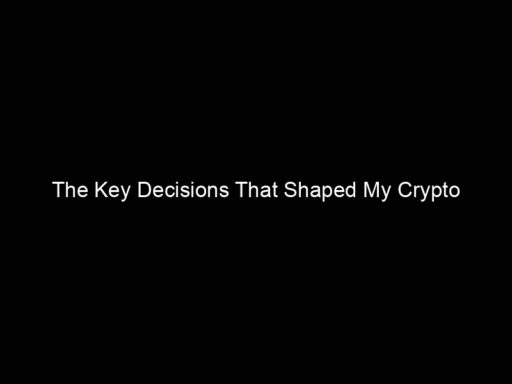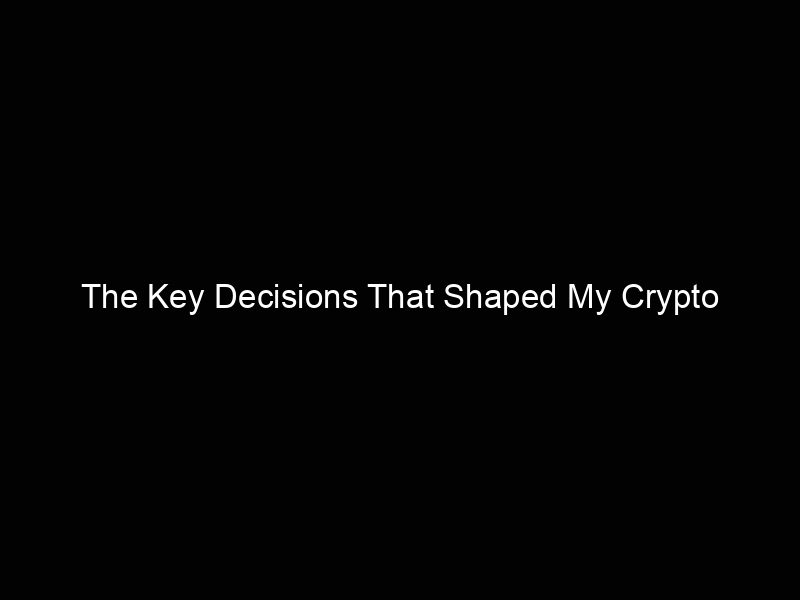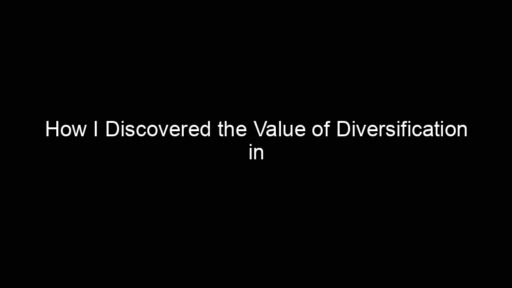Have you ever felt lost in the world of cryptocurrency? Trust me, I know the struggle! A few years ago, I was just like you—desperate to make sense of this fast-paced market and eager to find my place in it. I started my crypto journey armed with little knowledge and a lot of hope. But it wasn’t until I made a few key decisions that everything began to click for me.
In this article, I’ll share the key decisions that shaped my crypto investment strategy. From understanding why research and education are so critical, to learning the ropes of risk assessment, I’ll dive into everything I wish I knew at the beginning. You’ll see why diversifying your investments is more than just a buzzword and how being flexible can save your portfolio during turbulent times.
Get ready to discover the foundational principles that will not only make you a more informed investor but will also empower you to navigate the rollercoaster of cryptocurrency with confidence. Let’s embark on this enlightening journey together!
Understanding the Foundations of a Successful Crypto Investment Strategy
Research and Education: The Importance of Staying Informed
When I first jumped into the world of cryptocurrency, my excitement was through the roof. However, I quickly realized that without a solid foundation of knowledge, I was navigating a wild and unpredictable sea. Research and education became my lifebuoy. You see, the crypto market is always changing, and staying informed was crucial for my success.
To get started, I subscribed to reliable cryptocurrency news websites. This was my first step in dissecting market trends. I would spend each morning sipping my coffee while scrolling through articles about Bitcoin, Ethereum, and altcoins. Major news impacts the market, and knowing when new regulations or technological upgrades are announced helped me make timely decisions.
Beyond just news, I also sought out investment courses. There are countless resources available online, from free videos on YouTube to paid courses that dive deep into strategies. I took a few that were highly recommended by experienced investors. These courses taught me not just the basics, but advanced strategies that changed the way I viewed investing. I realized that the more I invested in my education, the better my investing decisions became.
Cryptocurrency Market Trends and News
Understanding market trends means keeping your ear to the ground. I remember the first time I noticed a trend: it was during a major price surge for Bitcoin. News articles highlighted institutional investments, and suddenly, more people were talking about crypto than ever before. This moment made me realize the importance of being aware of what drives the market. Whether it’s government regulations, technological advancements, or celebrity endorsements, these factors can cause prices to skyrocket or plummet.
By actively seeking news and trends, I could position myself correctly. I learned to be ahead of the curve, understanding that the earliest investors often see the most significant returns. With time, I became not just a reader of news but a critical analyzer. I started asking questions about the implications of different headlines—Did this news increase adoption? Will this affect a coin’s value in the long run?
Learning from Investment Courses and Resources
After diving into news, I spread my wings and explored educational courses. Initially, it felt overwhelming—who knew there were so many options? But I found several that suited my layman’s level and even more advanced ones as I progressed. One course, in particular, changed my perspective on risk management and emotional investing.
These courses equipped me with tools and frameworks that made my investment journey clearer. From understanding blockchain technology to familiarizing myself with different trading strategies, I gained the confidence to make informed decisions. It was invaluable!
Risk Assessment and Management
No one talks about risk enough, but it became one of the pillars of my investment strategy. Learning to assess risk transformed my approach to investing. I vividly remember a night filled with uncertainty when I had to decide whether to invest in a newly launched coin. I looked at the market volatility, historical performance, and the project’s legitimacy. That’s when I understood the importance of evaluating not just the potential gains but also the potential pitfalls.
Evaluating Market Volatility and Potential Pitfalls
The crypto market can be like a rollercoaster—thrilling but unpredictable. I distinctly recall the shocking drop one summer, when values plunged almost overnight. I was not prepared and felt panic creeping in. But the knowledge I had gained kept me grounded. I assessed my exposure to that volatility and realized I needed to have a clear plan. Setting stop-loss orders became a practice of mine, giving me peace of mind in turbulent times.
Now, I evaluate each new investment based on its inherent risks and adjust my portfolio accordingly. This method has allowed me to sleep better at night, knowing that I’m prepared for whatever the market throws my way.
Setting Realistic Goals and Expectations
One of the hardest lessons I learned was that flexibility is key. Early on, I was too focused on making a quick profit, leading to disappointment more often than not. Setting realistic goals became my new mantra. Instead of aiming for astronomical returns within a few weeks, I began looking at my investments with a long-term approach. My goal shifted to gradual growth and wealth accumulation.
I started crafting a timeline for my investments. For example, I decided that for certain coins, I’d hold them for at least a year. In doing so, I learned that patience pays off. Each time I met a milestone, no matter how small, it fueled my motivation and reinforced my strategy.
Now, when I talk about my investment goals, I’m much more sensible. It’s about understanding my financial dreams and matching them with a practical investment strategy. Just last week, I shared my experience with a friend who was eager to jump in, and I urged him to set realistic expectations as well. Getting rich overnight is rare; it’s smarter to be in for the long haul.
By investing in research, embracing education, assessing risks, and setting realistic goals, I laid down the foundations of my crypto investment strategy. Each of these components has not only strengthened my approach but has also made me a confident investor ready to navigate the exciting world of cryptocurrencies.
II. Strategic Decision-Making: Lessons from My Personal Experience
A. Diversification: Why Spreading Investments Across Assets Matters
When I first jumped into the world of cryptocurrency, I was all about putting my money into just one coin. It felt good to have all my eggs in one basket – or at least that’s what I thought. But boy, was I in for a lesson! The reality of the crypto market is that it is wild and unpredictable. One day, your favorite coin is skyrocketing, and the next day, it’s plummeting. That’s when I learned the hard truth about diversification.
I quickly realized that spreading my investments across various assets was crucial. This doesn’t mean I threw money at every coin I came across. Instead, I started analyzing different cryptocurrencies and their use cases. For instance, Bitcoin is often seen as digital gold, while Ethereum has smart contracts that open up endless possibilities. I learned that different coins serve different purposes.
By investing in a variety of cryptocurrencies, I could balance my risk better. So, if one investment didn’t perform well, the others could help cushion my losses. For me, it was like having a safety net. I felt more in control, like I was navigating a ship through a storm rather than being tossed about aimlessly.
1. Analyzing Different Cryptocurrencies and Their Use Cases
Once I embraced diversification, I took the time to explore various cryptocurrencies. I dove into their whitepapers, followed their development teams, and participated in online communities. Each cryptocurrency has its niche, which is fascinating. For example, I found that some cryptocurrencies focus on privacy, while others aim at decentralized finance (DeFi) solutions.
I’ll never forget when I learned about Cardano, which emphasizes a research-driven approach to blockchain development. This made me think critically about where to invest my money. Should I sink my funds into a well-established coin with a massive following, or explore a lesser-known gem with a promising technology stack? Research became my trusted sidekick.
This journey into analyzing different cryptocurrencies taught me to be open-minded. I began to see my investment portfolio as a garden, where each plant needs the right conditions to thrive. Some need water and sunlight, while others prefer shade. The same applies to crypto; each coin has its unique factors that can lead to growth or decline.
2. Balancing Short-Term and Long-Term Investments
Another game-changing lesson I learned was the importance of balancing short-term and long-term investments. Early on, my strategy was heavily skewed towards quick trades, which made me anxious. Every little market shift sent my heart racing. I soon realized that to succeed, I also needed long-term investments.
Setting aside a portion of my portfolio for long-term holds helped calm my nerves. I started looking at projects with strong fundamentals that I believed would thrive in the years to come. I focused on their real-world applications and how they might evolve in the crypto ecosystem. This perspective shift empowered me to be patient and less reactive to daily market fluctuations.
Creating a balance between these approaches made me feel more grounded. Instead of jumping in and out of trades, I learned to sit back and allow my decisions the time to unfold. With this strategy, I could enjoy both the thrill of short gains while also nurturing solid long-term investments.
B. Adapting to Market Changes: Flexibility in Trading Approaches
The crypto world changes faster than the weather! Keeping up with those changes is essential. I learned that being adaptable in my trading strategies was crucial to my investing success. There were countless times when I thought I had the market figured out, only to have it do a 180 on me.
I had to develop the skills to recognize signs of market shifts. For me, that began by tracking news and using social media to stay connected. Understanding how geopolitical events, regulations, and technological advancements affect crypto trends helped me make more informed decisions.
Another key component of adapting was technical analysis. I began studying chart patterns and price movements, which was overwhelming at first. But, with consistent practice, I started seeing the beauty in the numbers. Analyzing past performance allowed me to spot trends and predict potential market behaviors.
1. Recognizing Signs of Market Shifts and Adjusting Strategies
One particular incident sticks in my mind. There was a period when Bitcoin surged dramatically. Watching the price soaring got everyone excited — and yes, I got caught up in it too! But, as a diligent observer, I noticed that some red flags were looming. The volume was decreasing, and the sentiment shifted among seasoned traders. Instead of riding the wave, I adjusted my strategy and took some profits.
That moment taught me the importance of recognizing market signals. I realized that emotional investing leads to poor decisions. Instead, staying informed and being aware of the broader market context allows for smarter and adaptive trading strategies.
2. The Role of Technical Analysis and Past Performance in Decision Making
Lastly, I can’t emphasize enough how valuable technical analysis became for me. It’s like having a secret map that helps you navigate the unpredictable waters of cryptocurrency. Using various tools and indicators helped me view the market through a different lens.
As I explored past price movements, it became easier to see potential support and resistance levels. This insight empowered me to make better buying and selling decisions. For example, I learned to watch for bullish and bearish trends, which informed when to enter or exit a position.
Incorporating technical analysis into my strategy relieved some pressure. It shifted my focus from being solely reactionary to working proactively based on data and trends. The day I realized that past performance does indeed play a role in future price action was a turning point for me.
By combining these elements into my investment strategy, I slowly transformed my approach. Adapting to market changes and understanding market signals became vital tools in my crypto investment arsenal. With every lesson learned, I felt more empowered and knowledgeable in making my decisions.
As I reflect on my journey into the world of cryptocurrency, I realize that every decision I made along the way has fundamentally shaped my investment strategy. It all started with a thirst for knowledge. I spent countless hours researching, reading articles, and taking online courses to grasp the nuances of this complex market. Staying informed became my guiding star. I learned early on that understanding market trends and news is crucial. It’s not just about buying a coin and hoping for the best, but rather about being proactive and anticipating changes.
Risk management also played a significant role in my strategy. I learned to evaluate market volatility, assess potential risks, and set realistic expectations. This wasn’t always easy, but it was essential for building a stable investment portfolio. By knowing when to enter and exit the market, I could safeguard my investments while still making the most of promising opportunities.
Another key decision was to diversify my assets. Initially, I focused on just a few cryptocurrencies, but soon realized that spreading investments across multiple coins could mitigate risks and increase potential returns. I took the time to analyze various cryptocurrencies and understand their unique use cases. Balancing short-term trades with long-term investments became a game-changer for me.
Moreover, one of the most important lessons I learned is the value of adaptability. The crypto market is always changing, and having the flexibility to shift strategies based on market signals has proven vital. I cultivated the ability to recognize the signs of market shifts and adjusted my approaches accordingly. Using technical analysis helped me make informed decisions about when to buy or sell based on past performance.
In conclusion, my crypto investment strategy is a tapestry of research, risk management, strategic diversification, and adaptability. Each decision has not only influenced my financial growth but has also deepened my understanding of this remarkable world of digital assets. As I look forward, I’m excited to continue this journey, armed with the lessons I’ve learned, ready to navigate the waves of the crypto seas with confidence and clarity.






